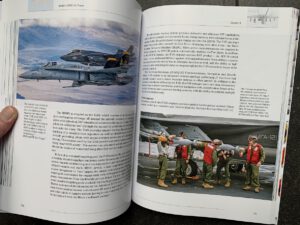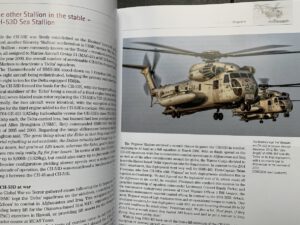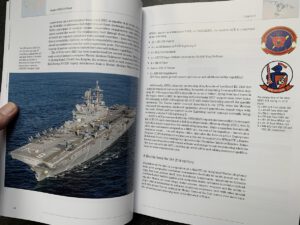273rd Review Modern USMC Air Power, Aircraft and units of the Flying ‘Leathernecks’- Joe Copalman
One of the best series
The books of Harpia Publishing had caught my eye before; strong through its logical built up and great because of the good finish and razor-sharp beautiful pictures. In the meantime, quite a series of books have been published. This is one of them again and tells about the Air Force of the US Marine Corps, written by Joe Copalman.
Transparent
The book contains a clear set-up; an introduction; abbreviations; a chapter about the history; a chapter about the organization of the USMC; then 12 chapters about the flying parts; a short chapter  about the future and a closing chapter with an overview of all currently used badges. The chapter about the history is an interesting entrance for this book; it describes that on May 22th 1912 LT Cunningham reported for training in one of the four water planes, but none of them were airworthy! Cunningham succeeded to fly a few months later with a plane from the Burgess Company. On August the 20th 1912 he flew, after 2.5 hours, solo. Nowadays you make a few more flying hours before you go solo! Anyway, from that moment on planes were part of the Navy, of which MC was an aspect. In August 1914 the marines started with flying ground planes. It must have been an exciting time to fly. Hardly to imagine that by now.
about the future and a closing chapter with an overview of all currently used badges. The chapter about the history is an interesting entrance for this book; it describes that on May 22th 1912 LT Cunningham reported for training in one of the four water planes, but none of them were airworthy! Cunningham succeeded to fly a few months later with a plane from the Burgess Company. On August the 20th 1912 he flew, after 2.5 hours, solo. Nowadays you make a few more flying hours before you go solo! Anyway, from that moment on planes were part of the Navy, of which MC was an aspect. In August 1914 the marines started with flying ground planes. It must have been an exciting time to fly. Hardly to imagine that by now.
The following pages take you along the deploy of the USMC at the start of the previous century, the Second World War, Korea, Vietnam, Middle East and the Balkan in the nineties. Also, short attention is given to the use of aviation at the USMC; Cunningham: ‘The only excuse for aviation in any service is its usefulness in assisting the troops on the ground to successfully carry out their operations’. The organization and all parts of the MC are explained; from training parts till the heavy and attack helicopters and from the development of ‘medium lift’ till attack and tank parts. Also transport, unmanned and test planes are listed.
 Good content
Good content
In all the chapters you will find good compact information about the developments during the last years, in those parts. Interesting bits of history (like the deploy of attack helicopters in Iraq, tragic accidents by which an impeller broke loose of a KC-130T on 20.000 feet and caused a fatal accident by which all occupants lost their lives. The cause was wrong maintenance through which things rusted. The impellor broke loose and penetrated itself through the hull with all fatalities as a result). All kinds of technical details of armoring and from the planes is elaborately set out. For fans of Cobra’s, transport helicopters, Ospreys, The F-35, The Harrier AV-8B, the Powler, The F-18 and not to be forgotten the F-5 Tigers, this book is a real must-have!
More than a good book
All-in all 250 pages thick, good and interesting information that easily reads away through the pleasant writing style of Joe Copalman, alternated with  great pictures. The 140 pictures are mainly color printed and of very good quality, often taken in the air. And then you are ‘done’ with reading this book and you realize that you have only just read about the enormous large ‘MC part’. The rest of the flying parts of the US Army is set out in other, already published and still to be publishes books. I am looking forward to it!
great pictures. The 140 pictures are mainly color printed and of very good quality, often taken in the air. And then you are ‘done’ with reading this book and you realize that you have only just read about the enormous large ‘MC part’. The rest of the flying parts of the US Army is set out in other, already published and still to be publishes books. I am looking forward to it!












Leave a Reply